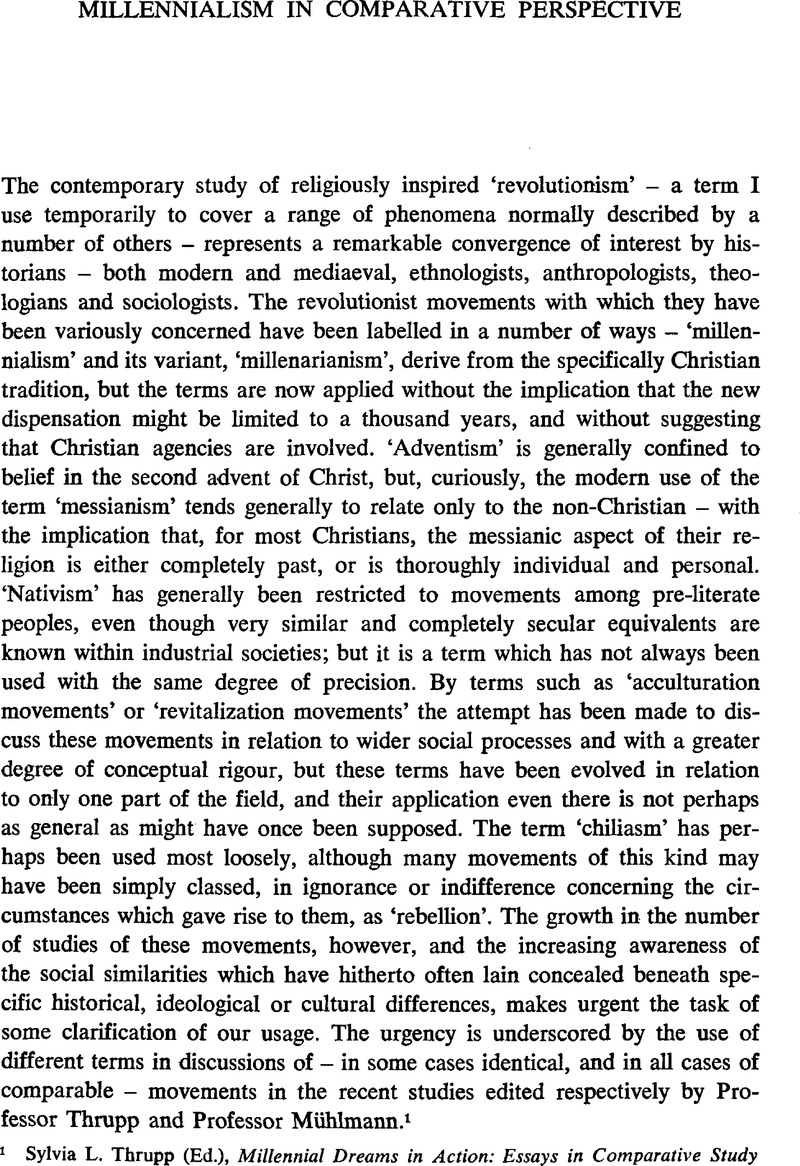Published online by Cambridge University Press: 03 June 2009

1 Thrupp, Sylvia L. (Ed.), Millennial Dreams in Action: Essays in Comparative Study (The Hague: Mouton & Co., 1962).Google Scholar This work contains papers by Sylvia L. Thrupp, Norman Cohn, George Shepperson, René Ribeiro, Eugene P. Boardman, Justus van der Kroef, Jean Guiart, Mircea Eliade, George E. Simpson, Howard Kaminsky, Donald Weinstein, Charles W. Jones, David F. Aberle, Marshall G. S. Hodgson, and Willson Coates. References to their papers in the work under review are not specifically noted hereafter, nor are those of the contributors to the volume edited by Professor Mühlmann. Mühlmann, Wilhelm E., Chiliasmus und Nativismus: Studien zur Psychologie, Soziologie und historischen Kasuistik der Umsturzbewegungen. Mit Beiträgen von Alfons M. Dauer, Willi J. Knoob, Wolfgang H. Lindig, Ernst Wilhelm Müller, Udo Oberem, Erika Sulzmann und Helga Uplegger (Berlin: Dietrich Reimer, 1961).Google Scholar
2 There are clearly cases of religious movements which might not meet these criteria the Unitarians and Universalists for instance, who have long ago surrendered their more specific, and gradually even their more general, supernatural goals. We can allow for such cases by suggesting that religious movements are movements which have, or have had, supernatural goals, or goals which involved supernatural operation.
3 Balandier, Georges, Sociologie actuelle de l'Afrique Noire (Paris: Presses Universitaires de Paris, 1955).Google Scholar
4 Revitalization is a concept developed by Wallace, A.F.C., “Revitalization Movements: Some Theoretical Considerations for their Comparative Study”, American Anthropologist, 58 (1956), pp. 264–281.CrossRefGoogle Scholar
5 Usher-Wilson, L.C., “Dina ya Misambwa”, Uganda Journal, 16 (1952), pp. 125–9;Google Scholar G. Balandier, op. cit.: Sundkler, Bengt, Bantu Prophets in South Africa (London: Lutterworth Press, 1948).Google Scholar
6 Worsley, Peter, The Trumpet Shall Sound (London: McGibbon & Kee, 1957);Google ScholarBodrogi, T., “Colonization and Religious Movements in Melanesia”, Acta Ethnographica Academiae Scientiarum Hungaricae, II (1951), pp. 259–290.Google Scholar
7 This point seems to be true in the general sense in which it is intended here, but it is not accepted without some qualification in detail by Slotkin, J.S., The Peyote Religion (Glencoe, Illinois: Free Press, 1956).Google Scholar
8 Guiart, Jean, “Culture Contact and the John Frum Movement on Tanna, New Hebrides”, Southwestern Journal of Anthropology, 12 (1956), pp. 105–116.CrossRefGoogle Scholar
9 Glock, C.Y., “On the Origins and Survival of Religious Groups” in Lee, Robert (Ed.) The Church and Social Conflict (New York: Oxford University Press,Google Scholar forthcoming).
10 It is not immediately apparent why expectation need be legitimate: frustration can arise as easily from a discrepancy between persistent unrealistic expectations and actuality-indeed the millennial movement is a capitalization of this circumstance, a substitution of more unreal expectation for whatever failed expectations were previously entertained.
11 It is also true that we find very different responses in the cases of downwardly and upwardly mobile people. Deprivation and downward mobility we may expect to give rise to a search for compensation: the new experience of abundance may sometimes require confirmation and reassurance-which is the function of gnostic sects. Oddly, at times there appears to be a coalescence of these functions of compensation and confirmation, as in the case of the British-Israelite tendencies which occurred among Christian Scientists in the 1920s and 30s. Until we know more about the self-identification and self-selection of groups our hypotheses must remain speculations.
12 Köbben, A.J.F., “Prophetic Movements as an Expression of Social Protest”, International Archives of Ethnography, XLIX (1960), pp. 117–164.Google Scholar
13 Smelser, Neil J., Theory of Collective Behaviour (London: Routledge, 1962).Google Scholar